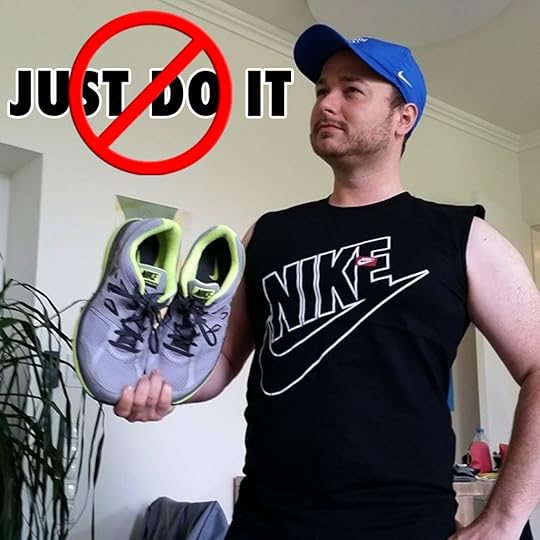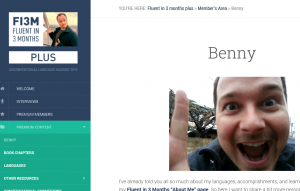Benny Lewis's Blog, page 95
August 7, 2014
How To Read The Russian Cyrillic Alphabet In Just A Few Hours
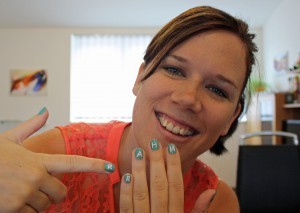 Since Lauren is learning Russian and had started with the Cyrillic alphabet first, we can see how important this is to begin on so that you can boost the rest of your progress. As such, it was great to get this guest post from Dani, who writes at isimplylovelanguages.com.
Since Lauren is learning Russian and had started with the Cyrillic alphabet first, we can see how important this is to begin on so that you can boost the rest of your progress. As such, it was great to get this guest post from Dani, who writes at isimplylovelanguages.com.
She’ll show you that it isn’t as bad as you think! Take it away Dani..
————
When somebody asks me what my major at university is and I tell them that I study Spanish and Russian, they often reply “What? Russian? Isn’t that difficult? They (the Russians) write differently!!”.
There are some tricky things about Russian and the script is definitely not the hardest part of the language. But it’s the first difference to our own language we come across when we get in contact with this language. And since the script is (somehow) unknown to us, it gives us the impression that Russian is difficult.
But once we get familiar with the unknown script and get over this first barrier, we can dive into the language and enjoy it like every other language. In this post I want to give you some bits of advice about how you can easily tackle this barrier and get familiar with the Cyrillic script.
By the way, you don’t need to speak Russian to make use of these tips!
Is it important to learn the Russian cyrillic script?
This question always comes up when a language is written in a script other than the Latin one. Of course, learning the script is an extra effort and everybody needs to decide if it’s necessary to make this effort to reach his or her personal goals.
In my opinion it’s important to learn Cyrillic script when you learn Russian (or any other language using this script). Even if you only focus on speaking, then the script could still be important to you. There are some phrasebooks available that provide a transcription for all words and phrases, of course, and you could learn from these. But when you are serious about Russian I guess it will be very difficult to avoid the script completely. Most dictionaries or grammar books don’t offer a transcription and I don’t know any Russian publications that use the Latin script instead of Cyrillic.
Also, if you plan to visit Russia as a traveller, it could be very helpful to know how to read the script. Even in the big cities, you often find Cyrillic street signs only. When I was in Moscow last year, I met many travellers at a hostel who complained that the underground stations are written in Cyrillic only. Many of them regretted that they hadn’t learned a bit of the script because Moscow is an international city and they feared that the “script situation” might get worse once they travel to smaller towns.
So even if you don’t plan to learn Russian itself, I highly recommend getting familiar with the Cyrillic script if you plan a trip to Russia. All you need is a rainy weekend and a positive mood!
It’s all about the letters
The Russian Cyrillic alphabet comprises 33 letters – that’s 7 more than the Latin alphabet. Many of these 33 letters look very familiar to what English speakers are used to:
A – E – K – M – O – T
These letters look like their Latin equivalents and have exactly the same meaning. Therefore you are already able to read words like мама or томат.
However, they are a few letters that look like Latin letters but have a different meaning.
В – Н – Р – С – У – Х
For example, the word нос looks very familiar to us and we are tempted to read hoc, but the letters here actually signify nos, which means nose. I would say that these are the six trickiest letters in the Russian alphabet because we associate a different sound with them. But this shouldn’t discourage you. After a few exercises you will get used to reading them correctly.
The remaining letters are alien to most of us:
Б – Г – Д – И – Й – Л – П – Ф – Ц
Ж – З – Ч – Ш – Щ – Ё – Ы – Э – Ю – Я
Ъ – ь
Just because the letters look different it doesn’t imply that the meaning behind them is different. Most of them represent sounds for which we either have a letter in the Latin alphabet itself or at least use the sound in our phonetic system. For example, ю represents the sound of you.
You might wonder now, how to memorize these new letters. In my opinion, it’s enough to practise intensively for a short period of time and then continuously focus on reading while studying. It’s like learning the Latin alphabet back at school. At the beginning it takes you about 20 seconds to read a word, later on you will be able to read it at first sight.
However, many people like to work with mnemonics. You can find several ones others have found useful on Memrise for instance, although I personally prefer to come up with my own memory hacks. I would be curious to hear about your ideas. For example, how would you remember the letter Ф, which represents the Latin F?
Now it’s about time to practise!
Decoding words
Do you like crosswords or other kinds of puzzles? Then you will love this method. Get some words written in Cyrillic and try and decode them letter by letter. This exercise is a lot of fun when you work with words whose meaning you will know once you decoded them.
For example: go to the Wikipedia article about the cities and towns of Russia by population and you will find a list of the biggest Russian cities in both English and Russian. Cover the English column (maybe print out the list before) and try to decode the Russian cities. Then you can easily compare it with the “solution”. You do not only practise reading but also learn something about Russia.
Or use the Russian article about the Oscar-winners. You can then try and decode the names of the famous actors. Sometimes it’s really funny how a famous name looks like written in Cyrillic. You can work with any article. If you find it difficult to find Russian articles, simply open up the respective article in English and switch to the Russian version which you can find in the left navigation column.
Reading & listening
It’s easier for us to retain things that we read AND hear. So when we hear a word or a text while we read it, it’s easier for us to remember. You can find hundreds of thousands of words pronounced by native speakers on forvo. By comparing the word and the audio file you can get a better feeling for how each letter sounds.
You don’t need to know how to type in Cyrillic at this point. You can easily copy the words you worked with from your decoding list. Or enter an English word into Google translator or any other online dictionary and copy the Russian translation. You could also work with frequency lists.
If you want to work with random words, forvo also offers a nice tool. When listening to a word, at the bottom of the article to this word below the map at the down left corner there is a small line that suggests a random word in the language you are currently listening to.
How your language exchange partner can help you
If you have a language partner who speaks Russian he or she can practise with you in many ways.
He or she could type easy words into the Skype chat and you try to read them aloud. It’s easier when you work with international names like famous singers etc. But you could also work with real Russian words that are appropriate for your learning level. After you read out the word, your partner can provide you with the English translation. This way, you not only improve your reading skills but also make progress in the language.
Your language exchange partner could also send some sentences or even short texts in Cyrillic via the chat function. The clue: the text is in English but transcribed into Cyrillic. This is more motivating than actually writing Russian sentences because you can be sure that you understand the meaning of the sentence once you read it out correctly.
But of course you could also work with real Russian sentences or texts. You can read them out and your language exchange partner can correct you if you read out any letters incorrectly. Just make sure that you don’t worry too much about understanding the text at this point.
Using the Russian keyboard
Now as we have practised reading the next step would be writing. There are some discussions on various language learning platforms about whether it’s necessary to learn the handwriting of a language as we mostly use computers or other devices for writing. It’s a legitimate question and I guess it depends on your personal goals and your attitude. I, for example, like to work with pen and paper, so I often use the handwriting.
So although I think the usefulness of learning the handwriting can be debated, I find it crucial to learn how to TYPE the Cyrillic alphabet. It’s not very difficult and it saves you a lot of time when you want to look up words or send an e-mail to a friend.
There are some software solutions out there that make typing in Cyrillic really easy. I’ve never used one of them because to me, the most natural way is simply using the regular keyboard and switching the language. Yes, it might take you a couple of hours to get familiar with the arrangement of the keys and at the beginning you will type slower. But eventually it pays off. You don’t rely on any software and you can use any computer.
You can easily change the language of your keyboard in the Control Panel (PC) – Time and Language settings. There you find ‘change keyboard’ and there you can ‘add’ a new keyboard. Once you added the Russian keyboard you can switch between the keyboards by a certain key sequence. The standard setting should be Alt+Shift.
Then find a picture of the ‘Russian keyboard’ on the internet and you can see the arrangement of the keys. Now you can start typing in Russian. At the beginning it feels a bit awkward and might feel a bit like the first IT-lessons in school (for those of who are older than 25…) when our teachers taught us how to type. But you will get faster and faster.
If you are more tech-savvy, I’d suggest go to Keybr.com, click settings, change the layout to Russian and practise away!
Mac users may want to check out this explanation.
You can practise typing by copying words, for example from the lists you worked with for decoding or from your vocabulary lists. You can also ask your language exchange partner to do a little text chat in Russian. Then you can practise reading and writing at the same time.
How long does it take to learn the Cyrillic script?
I would say it takes you a few hours to get started with the script. The rest is continuous practise that will happen naturally when you study the language. If you have a free afternoon or a weekend, grab a big cup of tea or maybe even some Russian sweets and just do it. Once you get started with the exercises you will see the progress really soon, I promise!
Maybe even ask a friend to join you. Everybody can learn the alphabet, even if he or she doesn’t learn the language itself. And it can be really nice and funny to share the struggle of reading and writing like a six-year old school kid. Don’t forget to share this article with them! 
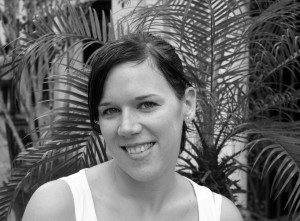 Dani is a passionate language learner from Austria who is fascinated by the variety of languages in the world. You can find out more about her and her language projects on
isimplylovelanguages.com
and connect with her on
Facebook
and
Twitter
.
Dani is a passionate language learner from Austria who is fascinated by the variety of languages in the world. You can find out more about her and her language projects on
isimplylovelanguages.com
and connect with her on
Facebook
and
Twitter
.
August 1, 2014
Fluent in 3 months road trip hits the east coast / midwest / south: Come talk language learning (free!)

The Fluent in 3 Months road trip is in full swing now! We’ve already done official events in the UK, Ireland, Amsterdam, California, Oregon, Washington, British Columbia, Ontario and Quebec, and in the last couple of days I’ve zoomed through Vermont and New Hampshire!
The west coast and Canada trip has been a huge success with standing room only in pretty much every single venue! Many languages were practised and a lot of people have told me that they felt inspired to finally dive into their own languages. I even got some emails after the event that they’ve had their first Skype conversation in the language 
But what is the Fluent in 3 Months road trip all about? Since our US East Coast / Midwest / South tour has begun, I thought it was the best time to address that!
You are all welcome to come along and get the best language learning encouragement you can imagine! It doesn’t cost a cent to attend - you are welcome to get your book signed, but you can come along even if you don’t have a book or aren’t buying one.
What happens at Fi3m events?
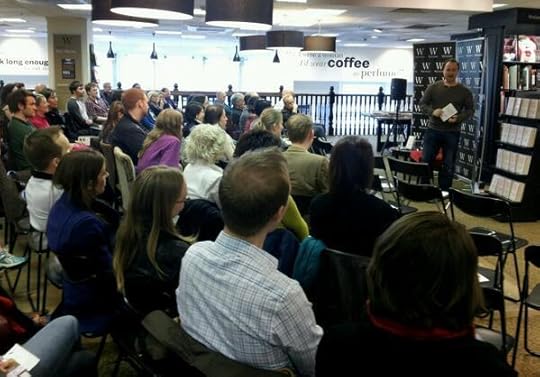
Definitely not your typical book signing, I consider these to be the best opportunity to get completely free language encouragement in person. The format of the events is generally:
20 minute overview of my language learning advice, for those not so familiar with it yet
Chance for the audience to ask questions. People hit me with whatever doubts they have and I give my best answers. This is the core of the event, and I like to leave no question unanswered, or no doubt not dealt with. This is always people’s favourite part, so I devote most of the time to it (30-40 minutes generally)
Language exchange practice. After my talk, I get people to separate into small groups to practise the language they are interested in. When we have enough people, there are generally a few with a great level and real practice takes place. Others get the chance to meet fellow learners in their city and exchange ideas.
A chance to speak with me one-on-one; I like to talk to each person for a couple of minutes, while they come up to get their book signed (no need to have a book though)
Also a chance to speak to Lauren my wonderful polyglot-in-training girlfriend and ask her about our travel logistics or the back-end workings of the blog, since she knows everything I do for that. You can also ask her how her Russian project is coming along, or how her Esperanto one went.
Photos! Join me in one of my token silly pose photos. A great example is this book war pose with John Fotheringham of Mastering Japanese, when I was in Seattle at the top of this post.
Upcoming events
We’ve starting in the very north east, working our way down to DC, across to Chicago, onward down to Florida, and finally heading over to New Orleans. Driving the entire way, and sometimes moving cities every other day! It’s intensive, but a great chance to spread some language learning encouragement 
So if you are in any of the following cities, please confirm your attendance on Facebook and I’ll see you there!
Northeast
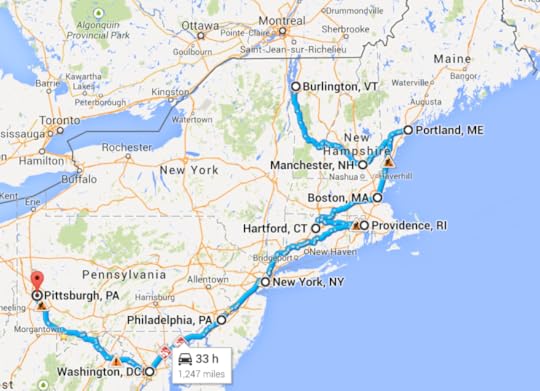
Burlington, VT, USA, July 30th
Manchester, NH, USA, July 31st
Portland, Maine, USA, August 1st
Boston, USA, August 4th
Hartford, CT, USA, August 7th
Providence, USA, August 8th
New York, USA, August 10th
Philadelphia, PA, USA, August 12th
Baltimore, USA, August 13th
Washington DC, USA, August 14th
Pittsburgh, PA, USA, August 18th
(All events confirmed with venues at your local bookstores!)
We’ll also do Baltimore, in October on our way out of the states, since Lauren is from there.
Midwest
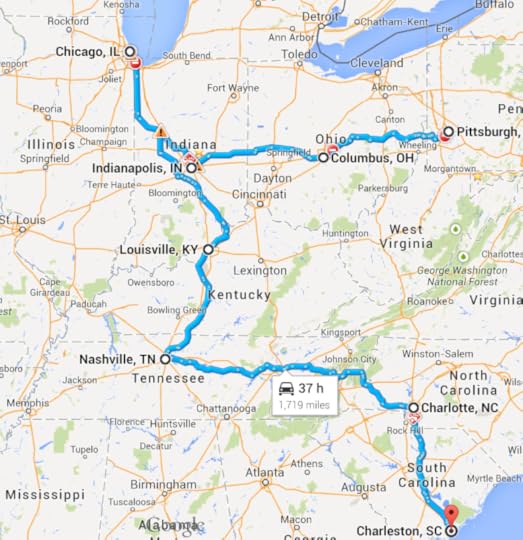
Columbus, OH, USA, August 21st
Indianapolis, IN, USA, August 23rd
Chicago, USA, August 24th
Louisville, KY, USA, August 28th
Charlotte, NC, USA, August 31st
Charleston, SC, USA, September 5th
(Note that these events don’t have a confirmed venue as of yet. We are doing final confirmations on most of them, only solidifying the time it takes place, but otherwise if you have connections with your local bookstore, please email me at benny+tour@fluentin3months.com and we may sign there if the date is available. Definitely sign up to the free event and you’ll get a notification on Facebook very soon about where it will take place)
South
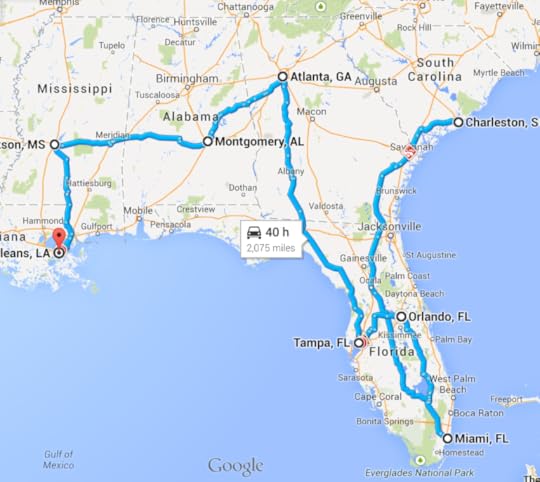
Miami, FL, USA, September 8th (Event added recently by popular demand with venue/time confirmed)
Orlando, FL, USA, September 10th
Tampa, FL, USA, September 12th
Atlanta, GA, USA, September 15th
Montgomery, AL, USA, September 16th
Jackson, MS, USA, September 17th
New Orleans, LA, USA, September 26th
(Note that most of these events don’t have a confirmed venue as of yet. We are doing final confirmations on most of them, only solidifying the time it takes place, but otherwise if you have connections with your local bookstore, please email me at benny+tour@fluentin3months.com. Definitely sign up to the free event and you’ll get a notification on Facebook very soon about where it will take place)
What’s next after the US book tour?
Yes, I know that we are missing a lot of cities – it’s pretty hard to set up a tour like this, especially since this is entirely self-funded and self organized (not through the publisher), but we will have successfully covered 25 states (as well as 3 Canadian provinces) by October!
Next summer we’ll be back to continue the tour in other states/provinces and visit certain cities we may have missed in states we’ve already been in.
After October of this year though, we will be in Asia again (more on that later) and making our way to Australia by the new year, so look out for info on Fi3m events there!
In another post, I’ll share more details on how this tour is going for those interested in the travel side of things.
Any questions about the tour? Otherwise, I hope to see you at one of these events soon  Let us know your thoughts or questions in the comments below!
Let us know your thoughts or questions in the comments below!





July 25, 2014
How To Be Organised About Learning New Vocabulary
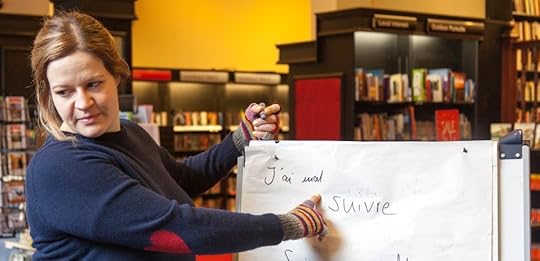
In today’s guest post, Kerstin from fluent language shares her thoughts on learning new vocabulary. Enjoy!
—-
My name is Kerstin and I’m a dictionary fiend. Learning new words and figuring out how they’re related to other languages is one of my favourite parts of language learning.
The following bits of advice about vocabulary learning are based on what works well for me, and even more on research into learning and teaching that I’ve done over the last year. Vocab is such a big topic that I found it was worth combining all the advice in a guide – my cookbook!
The whole process of building your vocabulary can be divided into four key stages: acquiring new words, memorizing them, revising and recalling.
Acquiring New Words
There are three ways that you can add new words to your vocabulary:
First
With the list of available words in any given language being potentially endless, a lot of language learners seek out high-frequency word lists. You can find these online, or purchase a curated word list like the French “Mot à Mot” or the German “Mastering German Vocabulary”.
For many people, this is a real strategy – the “I’ll study the 2000 most frequent words and then I’ll have basic fluency” approach. To be honest, that sounds about as appealing to me as getting to know new people by reading the telephone book.
Lists are for reference, they are there to remind of you what you already know. Starting with the list is not advisable in my book – that is not to say the lists aren’t useful, but your original vocabulary acquisition should come out of requirement and context.
I make one exception for times when you want to focus specifically on the writing skill, when I work with students to create and exercise involving common word lists. We create sentences featuring randomly selected words, building up to 10 common words into the sentence at once.
A fun and creative exercise, but for vocabulary acquisition I would recommend the following techniques much more:
Second
You can work with texts and videos in your target language and make notes of all the words you don’t know.
Now we’re getting warmer. Learning new words is dull as dishwater unless you get a bit of context, and the best advice I know is to get input that you can understand. I always teach new words in context through pointing them out in texts, repeating them with lots of examples or telling a little story. In fact, storytelling is the most useful way of finding new words and putting them to use straight away so that you will remember them.
There’s a really useful set of vocabulary acquisition and revision guidelines over at Omniglot, in which Simon recommends that intermediate and advanced learners should start working with parallel texts (books that are printed bilingually, with a language on each page or each side of a column). I do this a lot, it’s the literary equivalent of watching original films and shows with your own language subtitles.
Don’t turn your nose up at having the translation so nearby – it’s practical and helpful for understanding stories, and what’s interesting and fun will keep you going. Other great materials for early learners involve short stories and children’s literature, even picturebooks.
Be organised about researching and recording your new words and phrases, so they can be repeated on a regular basis. The actions for learning words from videos and books are to highlight, research and record.
Highlight the new word as soon as you find it, research it in a dictionary or online, then record it in Anki, in your vocabulary notebook, in a database or anywhere
Third:
Assuming that travelling to the target country isn’t an option – it usually isn’t for my students, though Benny is a clear example that it’s possible to live your life wherever you want in the world, as well as someone who learns away from the target country — you can find expert speakers, strike up a conversation and learn new words in real life.
If you are a beginner, do not get too hung up on learning from a native speaker, trust that anyone who is ahead of you has something valuable to teach. The great thing here is that you will always encounter a new word in its natural habitat, meaning there is no doubt about how it’s used or pronounced.
There is not a lot of advice that I would add to Benny’s own instructions on how to find and talk to people. You can refer to this Fluent in 3 Months article for more information. One thing that I love to do when travelling or visiting a foreign restaurant or shop is to really look around me, noticing signs and labels and looking for familiar words.
The last three times I travelled to Russia, I could be found wondering around Moscow pronouncing street signs and shop names like some kind of crazy lady. I was not crazy – I was practicing my Cyrillic!
If you’re past that complete beginner level, there is one question I so want you to ask people, and that is How do you spell that? It helps because first of all it puts the other person into “teacher mode”, meaning they’ll be ready to correct and improve your language. And secondly, how else will you take good notes?
Words Should Be Learnt From Anywhere
Any source of a new word is fair game! It doesn’t matter if you learn it from a book or from real life. I get a buzz every time I learn something new, it doesn’t matter which language it is in or where I found the word.
In fact, my own favourite place to get a quick fix in a new language is the ingredients list on food packaging like cereal boxes and cakes.
On the Importance of a Good Set of Notes
If there is a single action point you can take to become some kind of super effective language learner today, it’s to get organised about your note-taking.
I love me some good notes, and every time I observe what my most successful learners do, it’s that they really organise themselves extremely well. Buy a large notebook or a project pad, work with vocabulary sections, exercise sections and grammar sections. I honestly cannot imagine paperless language learning!
And if you want a language shortcut..
Shared vocabulary, or “vocabularly divergence” for linguists, is about how many words in languages are shared – often because they used to be the same hundreds of years ago or because of historic takeovers. For example, you can see how many European languages have hundreds of words in common.
How could it be different in a continent where tribes and countries have been conquering each other for thousands of years?! In fact, there are even little consistencies in how the words have been built into those other languages, such as the circumflex rule that where a French word has an “accent circonflex”, you will often find an s in the English equivalent.
Examples include “hâte” (haste), “hôpital” (hospital) and “forêt” (forest). Languages come in families, they are related and they share common roots (on my blog, I’m sharing this awesome vocabulary divergence map).
Knowing more about the relations between different languages is not just interesting, but also extremely helpful. If you choose to study a language which belongs to your native language family, you have an easier time learning new words. This is because you already know them. The grammar will also feel a little more familiar, and so on. In short, many people consider closely related languages easier to learn.
If There’s One Thing You Can Do Today…
You are ready to start mastering new vocabulary. There is never a wrong way to learn a language, but if you want to take a quick step, here is a summary of what you can do right now:
Ask how to spell new words that you learn in conversation
Establish a routine of highlight, research and record
Create a realistic and positive mindset – not “500 words this week”, but “every new word is a joy”
In the end, it’s about trusting the process. You’re not doing it wrong as long as you’re doing it. If you have built up that paperless learning system, by the way, I absolutely want to hear about it.
—
Kerstin is a native German speaker and has lived in the UK since 2003. She’s passionate about languages and has studied English, French, Italian, Latin, Spanish and Russian. Kerstin teaches and writes over at www.fluentlanguage.co.uk and her new book “The Vocab Cookbook” is out at the end of July. You can say hello to her on Twitter and Facebook and of course at www.fluentlanguage.co.uk.





July 15, 2014
How to Start Learning a New Language (Right Now. Today. Seriously).
Let me ask you a question:
If you really wanted to learn a new language, what would you be doing right now to make that happen?
The thing with language learning, and really with any goal or desire we have in life, is that we spend a lot of time thinking about what we want and talking about what we want, but way less time actually doing anything to get us towards that goal.
This isn’t news. People want a lot of things that they never do anything about. We all want to be in better shape. We all want to start eating healthier. We all want to learn new languages. So we start crafting these plans in our minds to start these projects “soon” or “tomorrow” or “next year” or “when we go to Paris” … and what ends up happening is that this mental process of “planning” actually tricks us into thinking that we’re on track towards our target, when in reality we have not yet taken a single step.
Right now rarely ever occurs to us to be a good time to start our projects. Instead, “soon” tends to be the most appealing option.
We leave A LOT of our problems to be solved by a future version of us, because we imagine that Future Us will somehow feel more motivated and energized, will have more time, more money, will have learned to wake up earlier, and will be managing life better.
So we wait.
I know this because I’m guilty myself of leaving tasks for Future Benny to solve.
The problem isn’t that we don’t have the information we need to get started right now. In fact, most of the time it’s the exact opposite! We know that we should exercise more, eat less, speak from day 1.
Future Benny is never going to have any better information about how to get started towards those goals than Right Now Benny does. Yet, in my mind, Future Benny just sort of feels like he’ll be more up to the challenge than Right Now Benny is.

Sorry to break this to you, but that is just not the case.
If you know what you want to do (learn Hungarian/Mandarin/Sign Language…), then the next step is doing.
So the question is: What would you be doing right now if you really wanted to learn a new language?
There are a few big truths about this I want to make clear.
1) Do nothing is not the answer
Obvious. And yet you are guilty of it, because thinking about learning a language is the same as doing nothing. Quite literally. Sorry to have to tell you this, but thinking about your goals will not get you any closer to achieving them. Only doing can do that.
This can be tricky, and it’s a black hole that we all fall down into at some point, because thinking about how we’ll achieve our goals feels good. It makes us feel excited about the amazing future person we imagine that we’ll be.
You might start to envision Future You learning Spanish, then going to Spain and making Spanish friends, ordering Sangria in the perfect Spanish accent, and being able to name 30 different types of tapas. This mental story – the process of imagining yourself going through all these steps – actually makes you feel like you have done something! And of course, in fact, you have done nothing but think your way out of taking action now.
Planning to learn a new language is also doing nothing, by the way. Even the best laid plans are not actions. They are just organized thoughts. Planning is thinking about doing - making decisions about how or when you’ll do something – but it occurs completely in your mind and involves no action. And definitely no language learning.
2) Researching the best way to learn a language is not the answer
Like thinking, spending endless hours on Google scouring the Internet for the “best” way to learn a language is NOT doing – although it definitely feels like it is.
Saving those websites in your bookmarks and putting that phrasebook in your Amazon wishlist makes you feel like you’ve done something. Do not trust that feeling! This is yet another endless downward spiral that can actually paralyse you rather than help you, because there will simply always be blog posts you haven’t read yet, and Internet search terms you haven’t Googled, and products you haven’t reviewed… and just an endless amount of information that will keep you busy “researching” until the end of time if you let it.
And what’s worse is that after you spend hours and hours reading advice about language learning, and trying to decide which course to buy, and being confused about which language learning technique is the best will, in the end, leave you feeling frustrated with all the uncertainty. And many of you will decide that “figuring out what to do” is just too hard, and you’ll quit. (…or, in reality, never get started).
I actually agree that figuring out what to do is too hard. It’s really hard, actually, if not entirely impossible. So I advice against it, and I suggest something else instead.
3) Just do it is not the answer
I don’t like the catchphrase Just do it for language learning because that leaves a question mark for you to fill in by deciding what exactly “it” is. I get this question all the time: What should I do to start learning Spanish? And actually, this question has a never-ending list of answers. It also has no answer. There is no one thing you “should” do to start learning a new language.
There are just lots and lots of options. And because I’m not you, I can’t tell you with total certainty which of those thousand potential starting points is the best one for you.
I can, however, tell you this: Any time you spend thinking about, planning or researching the best way to learn a new language would have been better spent actually studying and speaking the language.
So my advice to you is simple: Just start.
Just start.
Don’t worry about where to start. Don’t worry if the phrasebook you can afford isn’t the best one. Don’t worry about which of the four online courses you’ve found is the best. Just start. Start learning, start speaking, start reading, and you will be doing more actual language learning than any amount of thinking or planning or researching can ever give you.
The question I asked you at the start of this post was: What would you be doing right now if you really wanted to learn a new language?
The key idea here is RIGHT NOW, and the answer is something. Anything. It really doesn’t matter what you do, just start, and start now.
If you don’t want to start now, then you have to ask yourself, is this even something you really want? For some people, the reality is that they don’t really want to speak Japanese - they just kind of like the idea of it. And so they’ll spend their time thinking about how “cool” it would be to speak Japanese, but never actually learning to speak Japanese.
But if you really, really want to learn Japanese, then just start. Start doing the thing you want to do right now.
So how do I “just start”?
Recently, I launched a new free email course that guides you through the process of starting a new language project. It’s called “Speak in a Week” and it promises that if you follow its instructions, you’ll have a simple conversation in your target language in 7 days. It’s been a huge success, I get thank-you emails every day, and my readers love it.
You may be wondering what its trick is. I’ll tell you.
The trick appears in the very first day, when I give the starting challenge of the week. Are you ready? It’s pure magic.
Step 1 is… Learn to say Hello.
And then, when you’ve done that, learn to say My name is. And then learn to say Nice to meet you. It pretty much goes on like that.
Hopefully you’re seeing that the point here is that that there is no “trick” to getting started. You literally just start. And for me, since language learning is all about talking to other people, “Hello” seems like an ideal place to start. You may prefer to start with “My hovercraft is full of eels” instead, and if that’s relevant to you in some way, that’s fine too.
Are you ready to start?
Okay, so I’m being a little cheeky.
Of course there are hints and tricks I can give you about what you can do while you’re starting that will greatly increase your chances of success and help you keep up your momentum. But you need to decide right now not to just be a language hacking idea hoarder. Put these ideas to use already.
So since I’ve convinced you to get started today, I’ll share some key insights for getting started with you now.
1) Start learning with a buddy, group, or support network
2) Be public about your goals
3) Start in many ways, test things out, and change it up if you’re bored.
Lauren, my girlfriend, just completed her first ever language mission in Esperanto, and at the end of her challenge she wrote about the importance of using lots of different methods. This is key, and this is also why finding the “best” technique isn’t so important. During your project, you should use lots of techniques, and lots of resources, and you’ll learn faster. Just don’t be hesitant to start any particular one. Just start something, and if it’s boring, start something else.
Also, if you say your goals out loud on Facebook, on your own blog, on my forums, or anywhere else, it means that there is suddenly something at stake if you don’t follow through. When you announce your mission to the world, you’ll feel like now you really have to start. Good! If at all possible, surround yourself with other people who are also learning a language to keep you motivated, to steal ideas from, and who will hold you accountable for getting started and moving forward.
Lauren’s 3 Month Challenge Language Announcement (What’s Yours?)
Now, Lauren is starting her next language challenge! She’ll be joining forces with FI3M’s Language Encourager Brandon (who is learning Icelandic) to learn her next language with the support of 148 other language learners as part of Brian Kwong’s next Add 1 Challenge. You are welcome to join them by making your own video public announcement (like Lauren’s below) and signing up this week.
http://www.youtube.com/watch?v=LioeAKFOYgg
Lauren’s next language challenge (click to find out which language!). Join Add 1 to learn with her!
I want to know what your language goals are, so tell me in the comments. Make a public announcement here today to the world about what language goals are, what’s at stake for you, and how you’re going to make it a reality.
From there, your challenge is this: Just start. Pick up a phrasebook. Join the Add 1 Challenge. Learn to say hello. Just start. Today. Right now. Seriously.





July 10, 2014
How to travel the world for life (and work while you travel)

Today, July 10th, is my 32nd birthday! But it’s also my 11 year travel anniversary.
Back in 2003 I left Ireland this day with no return ticket, and 132 months / 574 weeks / over 4,000 days later, I’m still on the road with no home or place I can call a base. Everything I own in the world weighs 23kg/50lb and comes with me.
On my 8 year travel anniversary, I wrote my site’s most popular post ever by sharing the 29 most important life lessons I learned while travelling the world. And last year on my 10 year anniversary, I took those top-10 life lessons and presented them in a professionally edited video to summarize my travels visually.
This year, I’m doing something different and sharing my most practical tips on how you can keep up long-term travel like I have, without winning the lottery (or having a mega savings). All throughout my travels – for over a decade – I’ve paid my way from money I earned while travelling.
So, how do I do it?
First, you don’t need to save up money for years before you can begin a life of travel. So many people make this mistake in mentality, and as a result they put off their travel goals for years unnecessarily. In fact, starting a travel lifestyle right now is well within the possibility of many people. I realize that there are exceptions, and some people might not want to travel long term like I do, so today I want to give you a heap of ideas for how to manage your own travel goals, whatever they may be.
I’ll tackle four key points:
How to lead a cheap travel lifestyle
How to score cheap flights
How to get the cheapest (and sometimes free) lodging
How to work while you travel
If you’re really serious about starting a travel lifestyle, I’ll also share the best links for further reading on travel hacking. To get you started, you can’t get better than checking out Nomadic Matt, since I learned a lot of the strategies I now use myself from his book How to travel the world on $50 a day.
(Oh yes – since it’s my birthday, as a present request I’ll ask that you share this post on your favourite social media site (Facebook wall, retweet, Google+ share etc.) if you found it useful. Thanks! 
Enjoy!
How to travel the world for cheap

Before we discuss how to travel cheaper, it’s very important to tackle how to live cheaper. This applies to you right now, even while you are settled.
If you have expensive habits now in your settled life, those habits will follow you into your travel lifestyle and rack up unnecessary expenses. It doesn’t need to be this way.
So how expensive is your current life? Before you start travelling, track your actual expenses now and see where they go. Do you eat out a lot? Spend a lot on fuel costs? Does most of your money go to car or home insurance payments?
The good news is that if you start travelling for the long-term, you can live cheaper in part because you’ll no longer need to spend hundreds of dollars of month to pay for your car, its insurance, its gas… and all the other major expenses that comes with leading a settled life. When you think about it, with all of these major expenses, leading a settled life is expensive!
But if you’re finding that the biggest sticker shock comes from your lifestyle habits, then you’ll have to make some tough choices.
Can you cut back on coffee, cigarettes and beer in exchange for extra cash you can put towards train tickets to the distant corners of the world?
Not everyone can, or wants to. But if you can save just ten dollars a day by living a cheaper lifestyle … just 10 dollars a day! … that’s enough to pay the cost of your entire monthly rent for a hut on the beach in India or Thailand.
Think about that for a minute.
You might consider making other cheap lifestyle choices, like keeping a vegetarian diet and learning to cook from home. In a lot of countries, you can rely almost entirely on the use of public transport instead of a car, or get around on a bike. You can share accommodation costs by having room-mates. You can choose to be happy with the current technology and clothes that you have instead of updating them every few months.
These changes can increase the amount of your expendable cash dramatically.
After you learn to decrease the cost of your life in general, this will absolutely spill over into savings for your travel life. Then, I recommend you:
Follow these 25 travel on the cheap tips from myself and Graham Hughes (who has visited every country on earth on a shoestring budget)
Get rid of all your stuff. Use sites like Ebay, craigslist, gumtree, go to 2nd hand shops, the options are endless. There is no physical item that you actually can’t live without unless it is the clothes on your back, food, or your means of earning money (for me, that’s my laptop). This will both give you a financial boost and allow you to travel with all your posessions and not need to pay for storage or rent back home.
Learn how to travel with everything you own carried along with you.
When eating in a country, don’t forget to try to get a place with a kitchen if you can (many youth hostels have one) and cook your meals. Otherwise, try to eat out at lunch time instead of dinner, since many places do lunch specials. Cities like Berlin and Paris have great “business lunch” options that offer several courses for just a few euro. Also, do indeed visit tourist sites, but leave the area when it’s time to eat, since you’ll be paying tourist rates. Find out in advance where the locals eat.
My number one biggest tip by far for how to travel for cheap is to learn the local language. This will save you heaps of money. I honestly feel this is one of the main reasons that I’ve been able to afford to travel so long – I’ve avoided paying the “English speaking tax”, and trust me, that tax exists pretty much everywhere that English is not the native language.
How to find cheap airfare
 When your general lifestyle is less expensive, the next biggest expense people imagine is flights.
When your general lifestyle is less expensive, the next biggest expense people imagine is flights.
Flights, I’ll admit, can cost thousands of dollars. But if you know where to look, there are several ways to make these dramatically cheaper than you think. Here are some rules to live by when checking out flights.
1. Never go to the airline’s own website. Instead, use “meta-search engines” while check and compare the rates for multiple travel sites at once. Also, try to book tickets around 3 months in advance, and choose flexible criteria – especially for the exact day of travel. See what the cheapest day is during the week or month around when you can fly. You can save hundreds of dollars by flying even a single day earlier or later! And try multiple searches on several of the following websites until you get the best results:
www.skyscanner.com
www.momondo.com
www.kayak.com
www.expedia.com
www.adioso.com [This website uses natural language, so you can type “London to Southeast Asia mid May for 3 weeks” into the search box and Adioso suggests flights]
www.hipmunk.com [This site ranks flights by "Agony", taking inconvenience into account]
2. For long-haul, cross continental flights, use flightfox.com. For $49 they can save hundreds or get you nice upgrades. Definitely worth it for many people. I got Lauren’s return flight (from US to Spain to live with me for 3 months, then from Ireland to US for Christmas) for $450/€330, because of some strange rule where we added an extra leg to Canada 2 days after she landed in DC that she didn’t even take. This website did the research for us in a way you wouldn’t get on the above meta-searches.
3. If your goal is to fly a lot, you can use “Round-the-world tickets”, which can cost about €3,000+ depending on the number of continents you want to visit. You can book through airtreks.com or flightcentre.com, but it’s better if you can save miles through credit card sign-ups. This is more appropriate if you want to travel the world for a year and know where you want to go in advance. Using the above options and buying individual tickets still tends to work out cheaper most of the time though, and allows for more flexibility.
How to find cheap or free lodging

For those of you travelling very fast and moving around once every few days, travel will be more expensive, but you can reduce costs by getting last-minute prices on hotels on sites like laterooms.com, lastminute.com, hoteltonight.com, priceline.com, hotwire.com (name your price – you won’t know where you’ll stay until you’ve paid).
I can understand why people think long term travel is not possible for them, when they think it’s a $1-200/night hotel stay, but the fact of the matter is that long term travellers do not tend to stay at hotels.
Instead, we:
Stay for free with couchsurfing, servas (reference letter required, mostly US senior travellers), hospitality club, globalfreeloaders (I use Couchsurfing a lot for its search feature to find language learning partners too)
If you speak Esperanto, Pasportaservo.org is like the above sites with the only catch being that you communicate with your hosts in a language you can learn in a few weeks! (Here’s how well my girlfriend did with just an hour a day for 6 weeks)
Use wwoof.org (World Wide Opportunities on Organic Farms – about €20 per country membership – you work on a farm and get free accommodation, as well as the amazing experience)
House-sit at housecarers.com, mindmyhouse.com, caretaker.org – This is more suited to stays of a month or longer; you get free accommodation in exchange for keeping an eye on pets, gardens, and other chores.
Stay in youth hostels – as low as just $5/night in countries like Thailand, cheaper across Europe. Find your options on hostelworld.com or hostelbookers.com.
For stays of a few days or a few weeks, I highly recommend staying in a serviced apartment. For mid-range budgets this is my go-to choice. Find your home away from home on 9flats.com, airbnb.com, homeaway.com, roomorama.com, or wimdu.com.
Go camping! You are only paying for the space and can access water, electricity and other services as required in specialized campsites for a fraction of the cost of alternatives.
Here is more on how I find accommodation while travelling
How to work while travelling
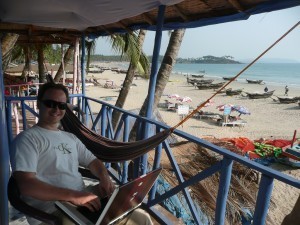
Most people think they have to save their pennies for months or years in advance until they have “enough” money to travel and live off of for a while. Unfortunately, this can only last you so long (unless you have won the lottery, in which case send a donation my way!  ). The fact is that you can earn while on the road.
). The fact is that you can earn while on the road.
There are two ways to do this:
1) Get a job on-location
If you are an EU citizen you can do this automatically in any other countries in the EU. In most other situations though, you need to obtain a visa in advance.
As an Irish citizen, I got a J1-visa to work in America twice when I was a student (this was part of the 6 months of travel I did before my 11-years-non-stop travel, so I am actually approaching 12 years depending on how you count it…) I applied for this through the Irish organization USIT. They also offer Irish people working visas in many other countries. Your country may have an equivalent service.
In most other situations, you may have to see in advance what your options may be. If you are a student, your university most likely offers study abroad options, and definitely use your network of friends and colleagues to see if any of your fellow students have experience working abroad.
If you are looking for a job on your own, it is actually usually much easier to get hired by a company before you travel, and then have that company arrange the visa. This was a possibility for me the first time I went to the US, because I worked as a summer school teacher for a university, which was experienced in hiring foreigners, so I actually didn’t need to arrange the working visa myself.
Finally, have a look at the country’s embassy website and see what they recommend for working visas.
What work can you do on-location?
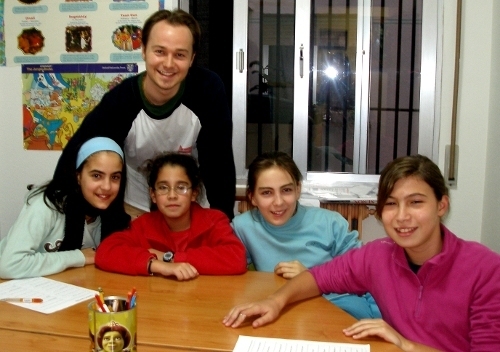
The easiest way by far that English speakers can work abroad is to do it as an English teacher. In countries were English teachers are in high demand, the school will arrange the visa and all logistics for you.
I’ve done lots of work as an ESL teacher myself, all based on an initial weekend affordable TEFL certificate I got from i-to-i, and then building upon my experience earned to get me higher paid jobs with time, eventually working for prominent schools like Berlitz and Wall Street Institute. I’ve also worked the following jobs on location, to give you an idea of your options (your options expand immensely if you learn the local language – don’t forget to sign-up to my newsletter for a week long crash course if you aren’t sure how):
Youth hostel receptionist
Store manager
Photographer
Basic office work
Engineer (what my undergraduate degree was in – in this case I worked as an intern)
Go Kart race controller
Computer repair / on-site tech support
Lots of English teaching
On-site translator
You may find other work depending on your work skills and the opportunities available.
2) Get a location independent job

I worked on-location for my first years travel, but the catch was that my wages remained stagnant for all work other than teaching English, since I moved every few months and had to start over from scratch again.
That’s why the future of many jobs (not all of course) is that they can be based online, and you can take them with you around the world!
Here are a few ideas:
If you are good at languages, and willing to go through training for it, become a freelance location independent translator. I found my initial work on proz.com
Teach your native language online. You can become a teacher on italki for instance and take your students with you wherever you go. My girlfriend did this for her first months of travel with me, and was working full-time with the work she got.
Become an online coach – while I do this myself to help people expand the popularity of their websites and craft their language learning projects, there are many ways you can implement this. I once met someone who earned her living coaching people to give up smoking (her background was in psychology) over Skype!
Write an e-book or sell a course online. My site fi3m premium supports this completely free blog (no spammy irrelevant advertising anywhere here – that’s a really poor way to do anything but cover hosting costs) through a video course and resource database. I used to sell an e-book too. You can distribute this yourself if you put the time into creating a really high quality free site/Youtube channel/podcast or similar that sends traffic to it. You can also sell it directly on Amazon (self published) or through various other channels. Note that traditional publishing is not a good way to earn a living for most people – my book is an international best seller and this does not translate into money in my pocket because of traditional publishing logistics.
Take a skill that you have and see if it works online. Here is a list of 64 ideas to work online depending on the skill. You can also see if job openings are available through various online advertising boards, or a job outsourcing site like oDesk.
What kind of working visa do I need?

The question of how you manage the logistics of working online is tricky because there are no international laws that govern such things. What many of us do is simply set ourselves up legally and officially in our home country – so we have a bank, and pay taxes there.
Then we stay in a country on a tourist visa – a grey line depending on where you go. I actually have a business visa while I’m in America right now, since its immigration tends to be the most strict about what I can and can’t do here – this is despite the fact that I am not actually technically employed for any of my time here, but my book tour is business of sorts. In most countries though, a tourist visa is OK for online workers. (Disclaimer: Please don’t take what I’m saying here as legal advice – I accept no responsibility if you run into issues!)
You aren’t legally working in the eyes of many countries as you are not taking any money or employment from its citizens, only spending, as any tourist would. In case you are wondering, the “3 months” in my blog title comes from the 3 month visas I typically have as my limit in most places 
How do I set myself up as a business?
Whether you should operate as a freelancer or start your own business depends on too many factors for me to cover here, most important of which being the kind of work you’ll be doing, but you can contact a lawyer in your home country if you are unsure.
You can receive payments directly to your bank account (when I was a freelance translator, my clients were European and bank transfers within Europe are free – working with American clients is a pain in the ass to be honest because they are one of the few first world countries that still insist on printing your money on dead trees, i.e. snail-mailing checks/cheques).
Another solution is to set up a pro or business paypal account, but keep in mind that you do pay fees for many transactions and withdrawals.
When everything is combined – working and travelling long-term is easier than you think

A really cool benefit of working location independently is that you can earn in a strong currency like the euro/dollar/pound and spend in a cheaper country where that money will take you really far. Leveraging currency differences is another thing that allows “technomads” to travel so extensively.
The combination of everything I’ve said in this post, namely
SPENDING less through a minimalistic lifestyle
Finding cheaper flights through a bit of research
Finding cheaper or free accommodation, especially through slower travel
Working online and earning in a stronger currency, while spending in a weaker one
Means that long-term travel is absolutely sustainable. I break some of these rules sometimes, like this year I’m travelling very fast on my book tour, and accommodation is much more expensive as a result, but flights are still cheap, we eat in as often as possible, we earn online, and we generally don’t spend much otherwise.
This kind of fast-travel wouldn’t be sustainable for me in the long-term, but we’ll be back to three month stays later this year, and back to saving plenty for intensive periods like this.
A good balance is the key, and this is precisely how I’ve been able to travel for 11 years straight.  I hope that answers most of your questions, but if anything is missing, feel free to ask me in the comments below! And don’t forget my birthday request – share this post with all your friends – especially those who’d like to travel. Thanks!
I hope that answers most of your questions, but if anything is missing, feel free to ask me in the comments below! And don’t forget my birthday request – share this post with all your friends – especially those who’d like to travel. Thanks!





June 30, 2014
My latest language learning creation: A NEW video-based website for language-learners
For a while now, I’ve been working on something new that you may have picked up on when reading the blog, but that I’ve never officially announced, because it wasn’t quite ready yet!
But after months of creating, researching, recording and planning, I’m very proud to tell you all about my new premium website for Language Hackers, Fluent in 3 Months PREMIUM.
Thanks for the support!
Your support has allowed me to keep working to improve my website and develop new and better Language Hacking materials.
And while I really appreciate all the support from sales of my print-book, I should make it clear that these sales do not support my site. Even though my book is an international best seller, it has actually costed me much more than I’ve earned from it. Traditional publishing is not practical for making earnings (I knew this long before the book ever touched a shelf), and I did it solely to inspire a whole new group of potential language learners that I can’t reach through online means.
Sales of my digital products are what always keep this site afloat, so thank you very much for that 
One thing I always try to do is use the proceeds I make from sales of my materials to make better materials. This is why I’ve always offered free lifetime upgrades with each digital product, so that you can see how your investments allow me to make my content better!
Fluent in 3 Months PREMIUM is the best material I’ve ever created, and I’m really excited to finally have it ready to its official launch!
Now, to celebrate the launch…
I’m giving $20 italki credit to everyone who joins PREMIUM in the next 3 days
Yep, all new sign-ups get $20 of credit to use on italki, until Wednesday at midnight EST. This is equivalent to 1-3 hours of professional 1-on-1 Skype based language lessons, depending on the teacher/lesson. So if you have been on the fence, and think you may get the product “some day”, you really should take advantage of the current offer!
You can get it now right here.
I actually have several videos describing how to use italki as part of the product itself, and can confirm that it is my go-to best resource of all (I’m in there every day!)
Huge speak-in-a-week success
This past week, I sent out a free course from my PREMIUM materials called Speak in a Week, and hundreds of language learners emailed me to say they had their first ever conversations in their target language. I am absolutely amazed!!
I want everyone to keep going! Keep progressing towards fluency! And most importantly to use my suggestions to prepare you to SPEAK in your language now! That free course introduces you to many more materials that will get you beyond that first week.
What’s inside PREMIUM?
The new product is actually an entirely new website I’ve been building from the ground up, that includes my original Speak from Day 1 video series plus several new video series.
One video series guides you through how I use my favourite language resources and give tricks for how I like to customize the best apps and websites to suit different needs.
The website also includes a massive resource database, with organized lists of seriously detailed language learning resources–things that me and my team have spent hours scouring the Internet for.
You’ll learn:
How to read manga in German
Where you can listen to “slow” Spanish radio just for beginners
How to take a free MIT course online in Chinese
Where to find music and lyrics for Arabic belly dancing music
… and more … as well as what free or cheap online courses you can start with now, today, to keep your momentum going. It’s all there!
I’ve been working hard for months to make this huge database of videos and other resources ready to go. I like to think of it as a massive expansion pack on my book and previous materials!
Something else I’m really proud of (Speak from day 1 members)
If you already bought my Speak from Day 1 video series at any point in the last several years, then check your email for a special thank you :). Thank you for supporting me in my older projects–you’ve given me the resources I needed to make these new materials possible!
And of course, I’ll be keeping my Free Upgrades for Life offer on this new product as well, so that you’ll be able to see in the future what your investment helps me to create.
Fluent in 3 Months PREMIUM took so much work, time, video editing, subtitling, research, organization, as well as web site design and management to create. And me and my team will continue expanding and improving it with time.
The very first video series I just launched from FI3M PREMIUM for free, my Speak in a Week series, has already changed so many lives. My team and I are overwhelmed by the positive responses and thank you emails.
Here are just a few:
“This has been more fun than I ever could have imagined. After 4+ years of attempting to learn Hindi on my own, but never speaking, I now have more offers for language partners than I would have believed possible. I also made a contact with a Native German speaker to help me relearn, and recall my German from so many years ago.
This has been a great experience. Thank you – Linda”
————-
“Hi Benny,
First off, [going on italki] was the scariest part of the challenge for me, I am really not a big asker for help and that has stopped me so many times so I am very happy excited to say that I did it!
I wrote an intro on italki, got corrected and found a language partner! I used you to introduce my learning project and she had read your book (not only do you make learning a language easier but connecting with people too!) so we are on for a conversation this Sunday!
So, thank you, thank you and thank you again! For giving me the momentum and getting me out there! Hope you are well and having a blast on your book tour!
One last time, thank you! – Leila”
————-
Hi Benny
First of all, thank you for using my Day 1 Romanian as one of your three examples
 it is the first time I have ever posted anything online like that so it really means a lot.
it is the first time I have ever posted anything online like that so it really means a lot.Secondly, I’d like to say thank you so much for this Speak in 1 Week program …. This programme is invaluable as it is holding my hand (and I believe many others) through this initial step before we make our own way in the world.
I really think this could be a follow up book for you
 hehe, whether one week, or maybe a little longer, I really look forward to see where we all end up by the end of the week.
hehe, whether one week, or maybe a little longer, I really look forward to see where we all end up by the end of the week.Thank you again,
Kenneth” (You saw his video as part of the successful day 1 spoken videos)
———
Thank you for sending all these emails and telling me how my products have affected your life!
Now I want this $20 italki offer to give you the inspiration and resources you need to tackle your language projects head on.
Get it here, just until Wednesday.
Now that we have launched this mega project, Lauren and I really look forward to focusing more on our US/Canada book tour to encourage you all face-to-face, as well as getting back into consistent blogging and helping language learners in as many ways as we can!
Thanks again so much for all your support. Exciting times are ahead 
P.S. Keep sending me emails telling me how my products have affected your language learning – I love reading them!





June 25, 2014
Introducing: Speak in a week free crash course (+ hundreds of inspirational speak-on-day-1 videos)
Time for a big and really cool announcement!
Yesterday, HUNDREDS of people started a new language project and posted a video of themselves speaking their new language on day 1.
Why? Because I just created a (completely free) video course on how to start a new language from scratch and have a conversation within a week.
I call it Speak in a week, and you can join this intensive course by signing up here (if you aren’t already part of the Language Hacking League - otherwise you would have already received the first videos).
Lauren, myself and the Fi3m team have been extremely busy behind the scenes for quite some time (while travelling almost every 2 days mind you), getting this incredibly in-depth course to speak your target language ready for everyone, and we are finally launching it this week. We are so excited and the initial test run has been absolutely amazing!
It’s called the “Speak in a week” course, and consists of a daily e-mail for 7 days with everything you could possibly need to know to have your first conversation with a native speaker of the language in less than a week from now. The conversation will be very basic, but your first step to launch you forward in your progress if you feel you can’t get properly started.
And it’s completely and utterly free.
Incredible results already from just day 1!
While this is a one week long course to have an actual conversation with a native speaker, I do maintain my “speak from day 1″ attitude, and make day 1 about creating your first output in the language that others can see. This is way more powerful than speaking aloud to yourself, because you are speaking to other people.
Even taking that first step and letting others see and hear you say “Hi, my name is X, nice to meet you, bye” can make a world of a difference!
You can see the hundreds of results of just that first day already right here on the official uploads page. It really is incredible to see so many people share their first ever public outputs of the language! It’s one big collection of beginner learners supporting one another 
Please visit that page and offer encouragement and feedback (especially if you see your native language spoken by people for the first time in their lives, or if you see that someone is learning the same language as you!)
Here is just a sample of some really cool uploads:
http://www.youtube.com/watch?v=bGRN4xVy5Cw
http://www.youtube.com/watch?v=EV35yH8u0JE
http://www.youtube.com/watch?v=3YAqwSR4B1E

Sign up to join in on the fun!
Once again, here is that sign-up box. This will also give you weekly language news (more on that soon) that is tirelessly researched by Fi3m member Joseph, with contributions from myself and the rest of the team, from around the entire web.
If you have already been enjoying the weekly course so far, share your thoughts in the comments below 
June 21, 2014
6 biggest lessons from learning to speak my first non-native language [Final video]
http://www.youtube.com/watch?v=HFi-lnoQVa4
Time for the final update on Lauren’ss 6-week-challenge! She successfully completed her mission, and was able to socialize, make new friends, and have fun in Esperanto. You can see it all happen in the above video.
I’ll hand the blog over to her, to share her thoughts:
The 6 biggest lessons from learning to speak my first non-native language
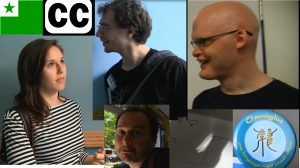
1. Everything seems impossible at first
I still remember how inept I felt during my first hour of study when everything was unclear –how the language sounded, what each word meant. But with time I started to notice the patterns and got used to the sounds. I feel like going into my next language project, I’ll be more aware that those feelings are just temporary, and be able to push through them much better.
2. I get bored quickly
Moving forward, I’m going to plan to make switching up my language practice part of my routine. I got bored at first when I tried to practice the same materials (Lernu, Anki, Memrise) for several days in a row, so it was really helpful to have Benny there to suggest alternatives. But he doesn’t speak the next language I plan to learn though, so I will have to find alternatives myself 
For my next language, I am going to take Polyglot Kent’s suggestion and try to incorporate memorizing the lyrics to songs in the language, which sounds like a really good way to help words stick in your mind.
3. It helps a LOT to have something or someone holding you accountable
The first time someone “friended” me on Memrise, I studied on Memrise twice as much that week. Just seeing their study points add up on the Memrise scoreboard motivated me to put more points on my scoreboard, too. And of course, having a weekly video to make was SO helpful in making sure I didn’t put off study time. I suggested to Benny that I need to have a language “sponsor” to help me stay on track. Which brings me to my next lesson:
4. Talking to someone on Skype for the first time was extremely intimidating
Before my Skype chat last week, I was really, really, really nervous. I don’t know why, I just was. And from knowing how I felt at that moment, I don’t think there’s anything I can say to help anyone else who experiences the same “pre-talk” nerves that I did. But what I can say is this: once the call started, I was fine. And my language partner was very nice.
And I’m really glad I did it! I feel like now I really understand why more people don’t “speak from day one” because it is really scary. But just try to push through it! Or find a language sponsor who will guilt you if you don’t!
5. Skipping study days sets you back
Studying for 3.5 hours twice a week is not the same thing as studying for 1 hour every day. I really feel it’s important to expose yourself to the language at least a little bit every day or else you’ll end up spending time in your study sessions remembering what you learned last time.
6. Teaching yourself a new language makes you feel really good

I really like the idea that I don’t need to rely on anyone else to teach me a language, but that anyone really can just get online and teach it to themselves. I found people to chat to for free on Lernu and I found my Skype partner through an Esperanto Facebook group. And I feel confident that I will be just as able to guide myself in learning my next language as I was to in Esperanto. I am really, really excited to see what I can achieve moving forward!
One last thing:
I will definitely continue to improve my Esperanto!
If anyone is wondering whether or not I thought learning Esperanto was “worth it” – definitely, yes. The community is extremely welcoming, the language is really fun to use, and studying it taught me a lot about how to learn a language in general. I’ve already started reading a book in Esperanto called “La Krimo de Katrina” and after that I plan to read the Esperanto version of Harry Potter!
Thanks Lauren! And of course, she will be using Esperanto as a springboard to help her learn her next language, which we’ll announce next week 





June 10, 2014
Lauren’s Esperanto project: Week 5 on Skype
http://www.youtube.com/watch?v=kKALPigtirY
We are now just a few days away from the Polyglot Conference that marks the end of Lauren’s 6-week project to learn Esperanto, and she’ll get a chance to use it to make new friends!
Because of that, rather than throw her in the deep end, in this last video I put her face-to-face (digitally) with an Esperanto speaker she didn’t know and she had to make conversation. Unlike in the last video, she only prepared a couple of questions, but most of her dialogue is spontaneous.
Considering we had some connection problems, I think she did a great job and is more than ready to meet Esperanto speakers. Let us know your thoughts in the comments 
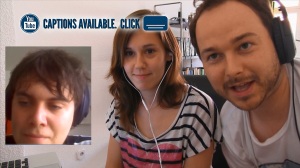





May 30, 2014
Week 4 of Lauren’s project: Chat in Esperanto

Time for another weekly project update! We have been really busy this week since getting to Amsterdam (fun things coming on the blog very soon!) so we focused the video on a chat with Lauren.
Since the first conversations we tend to have with new people we meet tend to be predictable, I told Lauren some example questions I’d like to ask her and she prepared her answers in advance. This kind of conversation may be the kind she may have on meeting someone and using the language for the first time, so it’s really helpful to know what she wants to say in advance.
Even spontaneous conversations can follow similar patterns, and as beginner learners we can take advantage of that!
As well as a general update, it’s also a chance for you all to get to know Lauren a little better  Speaking of which, here are her thoughts on how she’s doing!
Speaking of which, here are her thoughts on how she’s doing!
—————
For this week’s video, I wanted to test myself out on having a full, continuous conversation, with no help from a dictionary. Since my goal is to have casual conversations with other Esperanto speakers in Berlin, Benny decided to “interview me” with a few commonly-asked questions for practice.
Benny gave me a list of the questions he would ask (in English), and gave me some time to prepare by studying the vocabulary I would need to answer his questions. Our conversation in this video consists of Benny asking me his pre-made questions, which were written down on the computer in front of us, and me answering him entirely from memory, with no cheat sheets allowed 
I tried to push myself to go just a little bit more in-depth with my answers, rather than giving simply one-line responses, because I know that I won’t be able to only provide one line responses when I get asked questions at the Polyglot gathering in Berlin!
After watching my results, here are my goals moving forward:
(1) To improve my conversational vocabulary, and
(2) To improve the speed and flow of my responses and reduce hesitation
–both of which are what I need to get from where I am now to a conversational level.
Here is a detailed list of all the resources I’ve used so far to reach this stage:
Lernu course Ana Pana
Lernu grammar exercises
Lernu dictionary
Lernu messaging system and live chat feature
Memrise deck “Basic Esperanto Vocabulary”
Memrise deck “Speak Esperanto Like a Native”
Judith Meyer’s Esperanto Anki deck
“Posxamiko” (a pocket phrasebook)
Ilustrita Oficiala Radikaro Esperanta por Lernanto
Wikipedia in Esperanto
————–
Share your thoughts with us in the comments below!
----------------------------
Week 4 of Lauren’s project: Chat in Esperanto is a post from: Fluent in 3 months. Click through to the site to subscribe to the Language Hacking League e-mail list (on the top right) for way more tips sent directly to your inbox!
Have you seen my TEDx talk? You can get much better details of how I recommend learning a language if you watch it here.
As a subscriber you get a bonus sneak peak at the Language Hacking Guide! Download it here (zip) to read two chapters free of charge!







